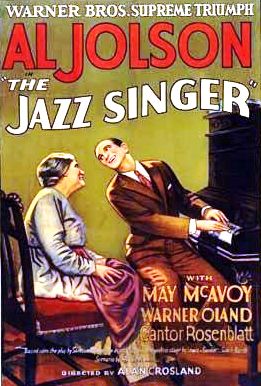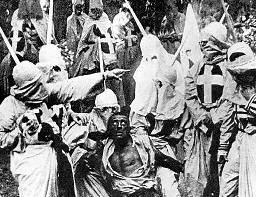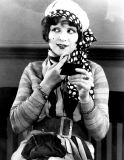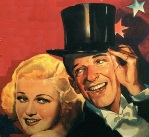|

The Golden Age of Hollywood
The Jazz Singer,
the First Talking Movie
|
Golden Age of Hollywood Facts: Fast Fact Sheet
Fast, fun facts and Frequently Asked Questions (FAQ's)
about the Golden
Age of Hollywood.
What was the Golden Age of Hollywood?
The Golden Age of Hollywood saw the
development of the Hollywood movie industry
with important movie milestones, the
production of famous, popular movies and the studio system that created movie
icons in the glamorous actors and actresses
who starred in the films.
When was the Golden Age of Hollywood?
The Golden Age of Hollywood started in 1915
and ended in 1963.
Why is it called the Golden Age of
Hollywood? The Golden Age of Hollywood
is so called because of the enormous amount
of money the movies produced and the images
of the glittering and glamorous movie stars
that filled the movie screens.
What started the Golden Age of Hollywood?
The Golden Age of Hollywood was started with
the production of the first major feature
length silent movie called the 'Birth of a
Nation' (1915).
Why did the Golden Age of Hollywood end?
The Golden Age of Hollywood ended with the
fall of the Studio System, ballooning
budgets and the emergence of television that
resulted in diminishing returns and decline
in profits.
Golden
Age of Hollywood
Facts -s for kids
The following fact
sheet contains interesting facts and information on Golden Age of
Hollywood, providing details of various milestones in the movie
industry from 1915 to 1963.
Facts about
the Golden Age of Hollywood for kids
Golden Age
of Hollywood Facts - 1: The American movie
industry was centred in Hollywood, Los Angeles in
California. The climate and location of Hollywood was ideal
place for outdoor filming and, by the 1920s, 85% of
American movie
production was made in or around Hollywood.
Golden Age
of Hollywood Facts -
2: The Golden Age of
Hollywood began when the first major feature-length
silent movie was made in 1915. The movie was called the
'Birth of a Nation' was based on the novel 'The
Clansman' by Thomas Dixon. The movie was directed by D.
W. Griffith who co-wrote the screenplay. The
feature-length silent movie lasted for 133 minutes and
made massive profits of $10,000,000. The epic movie
caused huge controversy and brought the full realization
of the Power of the Movies to America.
The inflammatory movie glorified the original Ku Klux
Klan which resulted in the
rebirth of the
1920s
KKK and brought protests by the NAACP with
riots in Boston and Philadelphia.

Golden Age
of Hollywood Facts - 3: The United
States entered into WW1 on April 6, 1917 and the Power of the
Movies was again demonstrated as Hollywood joined in the war effort
by making propaganda movies starring screen idols such
as Charlie Chaplin
Golden Age
of Hollywood Facts - 4: The 'Big Five' studios were
MGM, Paramount, Warner Bros., RKO and Fox. Universal, Columbia
Pictures, and United Artists were Known as the "Little Three"
studios that, unlike the "Big Five", did not own their own theater
chains.
Golden Age
of Hollywood Facts - 5: The studio system evolved in
Hollywood and was
essentially about long-term contracts for movie stars,
that prevented them being poached by rival studios.
Golden Age
of Hollywood Facts - 6: In 1919 the United Artists studio was
established by Charlie Chaplin, Douglas Fairbanks, Mary Pickford, and D.W. Griffith
to enable them to gain control of their own interests rather
than depending upon the 'Big Five' Hollywood studios.
Golden Age
of Hollywood Facts - 7: The popular silent
movie stars were idolized by millions, all over the
world - Silent Movies held no language barriers. The
most popular stars of the silent movie era were Marlene
Dietrich, Mary Pickford, Douglas Fairbanks, Clara Bow,
the Marx Brothers, Tallulah Bankhead, WC Fields, Lillian Gish,
John Barrymore, Norma Shearer, Joan Crawford, Charlie
Chaplin and "Fatty" Arbuckle.
Golden Age
of Hollywood Facts - 8: "Fatty" Arbuckle
was involved in one of the most famous scandals in
Hollywood which involved the alleged rape and murder of
actress Virginia Rappe. After 3 trials "Fatty"Arbuckle
was found not guilty and was acquitted, but his career
was left in ruins.
Golden Age
of Hollywood Facts - 9: In 1921 Rudolph Valentino created a sensation
starring in the major
movie role as "The Sheik" was made for under
$200,000 and exceeded $1 million in ticket sales. The movie studio
tried to squash a scandal that would erupt due to rumors that their
most popular movie star was gay or bi-sexual.
Golden Age
of Hollywood Facts - 10: Clara Bow, "The It
Girl" was one of the first sex sirens silver screen.
Clara Bow won a photo beauty contest which launched her
movie career in Hollywood. She was the epitome of the
1920s
Flappers and made 58 films. Her life was surrounded
by scandal and controversy. Clara Bow retired
in 1931, when she was just 28 years old, amid a tangle of scandals surrounding
numerous love affairs,
money and her addiction to alcohol. The scandals earned
her the nickname of "Crisis-a-Day-Clara".

Golden Age
of Hollywood Facts -
11: Other scandals
involving Hollywood in the 1920s involved famous figures
in the movie industry. The scandals involved the
licentious behaviour of Tallulah Bankhead and
other scandals involving drug abuse and alcohol
addiction implicated Mabel Normand, John Barrymore,
Wallace Reid and Barbara La Marr.
Golden Age
of Hollywood Facts - 12: In 1922 the first all-color movie
was produced in Hollywood, called 'Toll of the Sea', starring
Chinese-American actress Anna May
Wong.
Golden Age
of Hollywood Facts - 13: In 1922 the first 3-D movie
called 'The Power of Love', starring Noah Beery, was shown in front
of an audience when it was premiered at the Los Angeles Ambassador
Hotel
Continued...
Facts about
the Golden Age of Hollywood for kids
Facts
about the Golden Age of Hollywood for kids
The following fact
sheet continues with facts about Golden Age of Hollywood
Facts about
Golden Age of Hollywood for kids
Golden Age
of Hollywood Facts - 14: 1925 was another major landmark in the Golden Age
of Hollywood when the first movie with sound
effects and music, called 'Don Juan', was made by Warner
Brothers starring John Barrymore and Mary Astor.
Golden Age
of Hollywood Facts - 15: The United Artists studio scored a
box office hit with 'The Gold Rush'. Charlie Chaplin's
silent comedy, in his Little Tramp persona, made $4,250,000.
Golden Age
of Hollywood Facts - 16: In 1927 Warner Brothers released the
'The Jazz Singer' starring Al Jolson. The movie consisted mostly of music with only a couple of
hundred spoken words. 'The Jazz Singer' was an immediate
sensation and brought about the
demise of the silent movies and the ability to attract a world wide audience
with no language barriers. For additional facts and info
refer to the
First talking movie -
The Jazz Singer
Golden Age
of Hollywood Facts - 17: On November 18, 1928 Walt Disney's Steamboat Willie premiered
and introduced the world to animated cartoon films with
synchronized sound and to Mickey
Mouse and his girlfriend Minnie Mouse.
Golden Age
of Hollywood Facts - 18: In 1929 the first Oscars (Academy Awards)
were given in a short 15 minute ceremony at a
private hotel. Charlie Chaplin won an honorary award for
the 1928 silent movie,
'The Circus'.
Golden Age
of Hollywood Facts - 19: Betty Boop, the
animated cartoon character created by Max Fleischer,
made her first appearance in Dizzy Dishes (1930).
Golden Age
of Hollywood Facts -
20: The last silent
movie was released in 1931 - another milestone in the
Golden Age of Hollywood. By 1930 40% of America's
cinemas had sound systems installed.
Golden Age
of Hollywood Facts - 21: Movie Genres:
Popular movie genres of Hollywood in the 1920's were
gangster movies, epic movies, comedies, musicals,
thrillers, westerns and horrors.
Golden Age
of Hollywood Facts -
22:
Movies in the 1920s had liberally used nudity,
profanity, immorality in its themes and appeared to
endorse illegal drinking during Prohibition . The lives
of movie actresses, or "vamps" such as Clara Bow, with
their heavy makeup, scanty clothing and loose morals
together with the series of famous tinsel town scandals
had brought Hollywood under close scrutiny and mounting
criticism. Complaints led to the introduction of the
Hays Code and Censorship to
American movies during the Golden Age of Hollywood.
Golden Age
of Hollywood Facts - 23:
The Hays Code was a set of guidelines and rules that
enforced censorship on the American cinema. The Hays
Code was created in response to public complaints about
the lewd content of films and the scandalous behavior of
Hollywood movie stars and was voluntarily applied as a
form of censorship by the Hollywood movie industry. The
Hays Code was nicknamed "the motion picture industry's
Magna Charta of official decency" and had a significant
effects in the later movies during the Golden Age of
Hollywood.
Golden Age
of Hollywood Facts -
24: Pre-Code Hollywood
movies: The Hays Code was presented in 1930 but was not
rigidly enforced by 1934. The Hollywood movie industry
produced some notorious Pre-Code Hollywood movies during
the four year period, from March 31, 1930 to July 2,
1934, when the Hays Code and finally implemented. Refer
to Hays Code Facts for
background history and the events in Hollywood that led
to its creation.
Golden Age
of Hollywood Facts -
25: Pre-Code Hollywood
movies: Hollywood took advantage of the lax period and
produced movies including "Scenes of Passion" with
themes of adultery and illicit relationships. This type
of movie included 'Faithless' starring Tallulah Bankhead
(1932), 'Blonde Venus' starring Marlene Dietrich (1932)
and 'She Done Him Wrong' starring Mae West (1933).
Golden Age
of Hollywood Facts -
26: During the Great
Depression (1929 - 1941) audiences sought total escapism
or films they could relate to. In the 1930s social
consciousness films were produced and Disney cartoon
films became popular.
Golden Age
of Hollywood Facts -
27: Screwball
Comedies, like 'Bringing Up Baby (1938)' with Cary Grant
and 'My Man Godfrey' (1936) delighted audiences. But
even movies such as 'It Happened One Night', Claudette
Colbert and Clark Gable (1934) fell foul of the Hays
Code and "no scenes of passion".
Golden Age
of Hollywood Facts -
28: Musicals,
especially those starring Fred Astaire and Ginger
Rogers, provided escapism for their audiences in the
Golden Age of Hollywood. The Fred Astaire and Ginger
Rogers musicals were produced by RKO Studios and
included Flying Down to Rio (1933), Roberta (1935), Top
Hat (1935) and Follow the Fleet (1936). Ginger Rogers
and Fred Astaire made a total of 10 musicals together.
Ginger Rogers did everything Fred Astaire did, except
backwards and in high heels!

Golden Age
of Hollywood Facts - 29: Gangster Movies,
starring George Raft, James Cagney, Humphey Bogart and
Edward G Robertson were popular stars in the 1930s
starring in movies such as Angels with Dirty Faces, The
Maltese Falcon, The Roaring Twenties and G Men.
Golden Age
of Hollywood Facts - 30: For the family
audience, child star Shirley Temple came into her own
into movies like Stand Up and Cheer (1934), The Little
Colonel (1935), Curley Top (1935), The Poor Little Rich
Girl (1936),Heidi (1937), and The Little Princess
(1939).
Golden Age
of Hollywood Facts - 31: The story of the Civil war was told
in the epic romance 'Gone with the Wind' (1939) starring
Clark Gable and Vivien Leigh. Based on Margaret
Mitchell's top-selling novel it was probably the most
long-awaited movie in the history of Hollywood. Fans
immediately favored Clark Gable in the role of Rhett
Butler (even though he believed the role would
ruin his masculine image) but the question of the day
was who would play the part of Scarlet O'Hara. The movie
studio started a nationwide search for Scarlet and
famous stars such as Joan Crawford, Tallulah Bankhead
and Paulette Goddard desperately jostled for the part
which eventually went to English actress Vivien
Leigh.

Golden Age
of Hollywood Facts - 32: 'Gone with the Wind' (1939) received
8 Oscars including Best Film. Hattie McDaniel who played
Mammy in the movie became the first
African-American to win an Oscar, but was racially
segregated from her co-stars at the awards ceremony at
the Coconut Grove and made to sit at a separate table at
the back of the room.
Golden Age
of Hollywood Facts - 33: More serious
movies like the John Ford film, How Green Was My Valley
(1941) and The Grapes of Wrath (1940) based on John
Steinbeck's novel were popular with audiences in the
Great Depression. As did the truly wonderful the Wizard
of Oz in which Judy Garland is carried from the
Depression-struck farm in Kansas by a tornado and lands
in magical kingdom of Oz. Judy Garland famously sung
"Somewhere Over the Rainbow" an uplifting song of hope
for Americans enduring such hard times.
Golden Age
of Hollywood Facts - 34: Frank Capra films
also struck a chord with Americans during the Great
Depression with movies such as Mr. Deeds Goes to Town
(1936) and continued the theme of the common man in the
1940s with 'It's a Wonderful Life' starring James
Stewart (1946).
Golden Age
of Hollywood Facts - 35: Mention should be
made of Westerns. John Wayne was the king of the
westerns and starred in 84 movies of this genre starting
with The Big Trail in 1930 and the Shootist in 1976.
Golden Age
of Hollywood Facts - 36: Swashbuckler films
provided a perfect vehicle for many movie stars during
the Golden Age of Hollywood. Douglas Fairbanks starred
in swashbucklers from 1920 to 1929 and Errol Flynn from
1935 to 1941. Errol Flynn was idolized in his role
'The Adventures of Robin Hood' (1938) but was subject of
a damaging Hollywood scandal in in 1942 when two
underage girls, accused him of statutory rape. He was
acquitted of all charges but 'mud sticks' and his career
never really recovered
Golden Age
of Hollywood Facts - 37: Beginning in the 1940s Bob Hope and
Bing Crosby partnered together as a wise-cracking in a
series of 'Road' films with actress Dorothy Lamour.
Golden Age
of Hollywood Facts - 38: World War 2
(1939-1945) interrupted the Golden Age of Hollywood as
famous movie stars joined the armed forces including
Henry Fonda, Clark Gable, Jackie Coogan, James Stewart
and Douglas Fairbanks. Propaganda movie shorts were
produced such as Winning Your Wings, Combat America and
Mission Accomplished.
Golden Age
of Hollywood Facts - 39: Golden Age of
Hollywood continued with famous movies in the 1940s
including Casablanca (1942), The Philadelphia Story
(1940), Double Indemnity (1944), Citizen Kane (1941),
The Third Man (1949) and The Best Years of Our Lives
(1946) which was the most successful film of the decade.
Golden Age
of Hollywood Facts - 40: The early 1950s
witnessed the House Un-American Activities Committee
investigating Hollywood. Hearings resulted in the
blacklisting of many actors, writers and directors,
including Charlie Chaplin and the brilliant author and
screenplay writer Dalton Trumbo.
Golden Age
of Hollywood Facts - 41: The MGM musicals
breathed some light relief into the movies and the
Golden Age of Hollywood with the production of 15 years
of musical films under the leadership of the producer
Arthur Freed. The music and lyrics were composed by
people such as George and Ira Gershwin, Cole Porter,
Jerome Kern, Irving Berlin, Harold Arlen, Rodgers and
Hart and Rodgers and Hammerstein. The names of the
musicals included Anchors Aweigh, Annie Get Your Gun,
Show Boat, Kiss Me Kate, On the Town, Singin' in the
Rain, An American in Paris, Seven Brides for Seven
Brothers and It's Always Fair Weather. The MGM musicals
starred actors and actresses such as Gene Kelly, June
Allyson, Debbie Reynolds, Van Johnson, Jane Powell, Russ
Tamblyn, Esther Williams, Donald O'Connor and Howard
Keel.
Golden Age
of Hollywood Facts - 42: Epic Movies also
dominated the movies in the 1950's including Ben-Hur
(1959), The Robe (1953), The Ten Commandments (1956),
Quo Vadis (1951), Demetrius and the Gladiators (1954),
the Land of the Pharaohs (1955) and The Vikings (1958).
The most popular actors who starred in this genre of
movies included Charlton Heston, Kirk Douglas, Victor
Mature, Tony Curtis and Robert Taylor.
Golden Age
of Hollywood Facts - 43: Spartacus (1960),
about a Roman slave who leads a rebellion against Rome,
was a another epic with over 10,000 extras (many from
the Spanish Army). Directed by Stanley Kubrick it
starred Kirk Douglas, Tony Curtis, Peter Ustinov, Woody
Strode, Jean Simmons and Laurence Olivier. The movie is
one of the best ever made. Apart from the acting,
special mention should be given to Kirk Douglas who
risked the movie by publicly announcing that the
blacklisted Dalton Trumbo was the screenwriter of
Spartacus.
Golden Age
of Hollywood Facts - 44: The Movie Industry
tried to combat the rise of television used film formats
that could only be appreciated in the wide-screen of the
cinema. These included experiments with multiple-camera
wide-screen Cinerama, stereoscopic 3-D, CinemaScope,
VistaVision, Todd-AO and Panavision. Despite these
efforts attendance dropped each year until by 1964 it
had dropped by 75% since 1946. The end of Golden Age of
Hollywood was insight.
Golden Age
of Hollywood Facts - 45: The story of the
Golden Age of Hollywood started with one epic, the Birth
of a Nation, and ended with another - Cleopatra. Joseph
Mankiewicz’s Cleopatra marked the beginning of the end
of the Golden Age of Hollywood. The movie starred
Elizabeth Taylor and Richard Burton. Elizabeth Taylor
was paid $1 million for starring as Cleopatra. The film
was a financial disaster and nearly bankrupted 20th
Century-Fox. Both Elizabeth Taylor and Richard Burton
were married to other people at the time and their
affair sparked one of the most publicized scandals in
the history of Hollywood. Cleopatra saw the end of the
Golden Age of Hollywood as other studios opted to make
less expensive films in favor of more character driven
movies of the mid 960s and early 1970s.
Golden Age
of Hollywood Facts - 46: Why are the movies
of the Golden Age of Hollywood still so popular today?
The structure of the movies made easy viewing with a
beginning, middle and an end. Today, films such as Pulp
Fiction, are more difficult and confusing to follow.
Other people dislike the graphic portrayal of violence
and the use of profane language. But most Americans
enjoy the nostalgia evoked by the Golden Age of
Hollywood and hold fond memories of the glamour of the
old Movie Stars.
Facts about
Golden Age of Hollywood for kids
Facts
about
the Golden Age of
Hollywood
For visitors interested in the history of
Hollywood refer to the following articles:
Golden Age of Hollywood: Video of US Presidents
The articles
for the Golden Age of Hollywood provides historical facts and information about the
important historical events
that occurred in Hollywood. The following video will give you additional important facts, history and dates about the
personal and political lives of all the US Presidents, adding to your knowledge of United States History.
Golden Age of Hollywood
● Events for the
Golden Age of Hollywood history for kids and schools
●
Key historical events
in the Golden Age of Hollywood
●
Important, key, historical events of Golden Age of
Hollywood
for kids
●
Facts about the
Golden Age of Hollywood, movies, actors, actresses
●
Fast, fun, interesting facts on the Golden Age of
Hollywood
●
Important
movies in the Golden Age of Hollywood
●
Golden Age of
Hollywood
for kids for schools,
teachers, homework, kids and children |